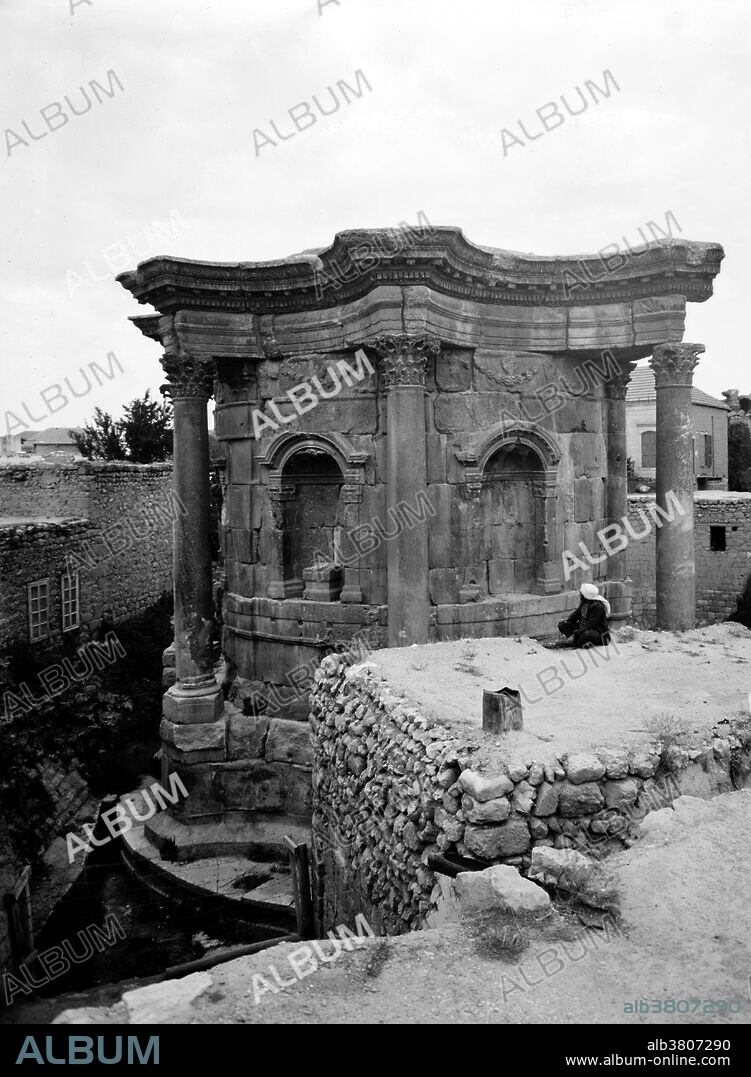alb3807290
Temple of Venus, Baalbek, 1936

|
Añadir a otro lightbox |
|
Añadir a otro lightbox |



¿Ya tienes cuenta? Iniciar sesión
¿No tienes cuenta? Regístrate
Compra esta imagen.
Selecciona el uso:

Título:
Temple of Venus, Baalbek, 1936
Descripción:
Traducción automática: El Templo de Venus fue añadido por Septimio Severo a principios del siglo III, pero fue destruido por Constantino, quien erigió una basílica en su lugar. Se encuentra a unos 150 metros de la esquina sureste del Templo de Baco. Era conocido en el siglo XIX como El Barbara o Barbarat el-Atikah (Santa Bárbara), habiendo sido utilizado como iglesia ortodoxa griega hasta el siglo XVIII. Baalbek es una ciudad en el valle de Beqaa del Líbano situada al este del río Litani. Después de que Alejandro Magno conquistara Oriente Próximo en el 334 a. C., el asentamiento existente recibió el nombre de Heliópolis. La ciudad mantuvo su función religiosa durante la época grecorromana, cuando el santuario del Júpiter-Baal heliopolitano era un lugar de peregrinación y uno de los santuarios más grandes del imperio. A partir del último cuarto del siglo I a. C. (reinado de Augusto) y durante un período de dos siglos (reinado de Filipo el Árabe), los romanos construyeron en Baalbek un complejo de templos compuesto por tres templos: Júpiter, Baco y Venus. En una colina cercana, construyeron un cuarto templo dedicado a Mercurio. Fotografía del Departamento de Fotografía de la Colonia Americana (Jerusalén), 1936
The Temple of Venus was added under Septimius Severus in the early 3rd century but destroyed under Constantine, who raised a basilica in its place. It lies about 150 yards rom the southeast corner of the Temple of Bacchus. It was known in the 19th century as El Barbara or Barbarat el-Atikah (St Barbara's), having been used as a Greek Orthodox church into the 18th century. Baalbek is a town in the Beqaa Valley of Lebanon situated east of the Litani River. After Alexander the Great conquered the Near East in 334 BC, the existing settlement was named Heliopolis. The city retained its religious function during Greco-Roman times, when the sanctuary of the Heliopolitan Jupiter-Baal was a pilgrimage site, and one of the largest sanctuaries in the empire. Starting in the last quarter of the 1st century BC (reign of Augustus) and over a period of two centuries (reign of Philip the Arab), the Romans had built a temple complex in Baalbek consisting of three temples: Jupiter, Bacchus and Venus. On a nearby hill, they built a fourth temple dedicated to Mercury. Photographed by the American Colony (Jerusalem) Photo Department, 1936.
Personas:
Crédito:
Album / LOC/Science Source
Autorizaciones:
Modelo: No - Propiedad: No
¿Preguntas relacionadas con los derechos?
¿Preguntas relacionadas con los derechos?
Tamaño imagen:
3300 x 4500 px | 42.5 MB
Tamaño impresión:
27.9 x 38.1 cm | 11.0 x 15.0 in (300 dpi)
Palabras clave:
1930S • 1936 • ANTIGUO • ANTIGÜEDAD • ARQUEOLOGIA • ARQUEOLÓGICA • ARQUEOLOGICO • ARQUEOLÓGICOS • BAALBEK • BLANCO Y NEGRO • CIENCIA • CIVILIZACION ANTIGUA • CULTURA ANTIGUA • FAMOSA • FAMOSO • FOTO • FOTOGRAFIA • GRECO-ROMANO • GRIEGO • HISTORIA • HISTORICO • IMPERIO ROMANO • IMPORTANTE • MONUMENTO • MUNDIAL DE LA UNESCO PATRIMONIO DE LA HUMANIDAD • PATRIMONIO DE LA HUMANIDAD • PERIODO HELENISTICO • RELIGION • RELIGIOSO • ROMA IMPERIAL • ROMANO • RUINAS • S. XX • SIGLO XX • SÍTIO • TEMPLO CIRCULAR • TEMPLO DE VENUS • TEMPLO
 Pinterest
Pinterest Twitter
Twitter Facebook
Facebook Copiar enlace
Copiar enlace Email
Email
